Mad Hedge Technology Letter
February 14, 2024
Fiat Lux
Featured Trade:
(A BIG RISK WITH AI)
($COMPQ)

Mad Hedge Technology Letter
February 14, 2024
Fiat Lux
Featured Trade:
(A BIG RISK WITH AI)
($COMPQ)

What makes AI mesmerizing and, at the same time, weird is the fact that the technology is accessible to everyone.
Remember when computers were so expensive only a handful of people like Bill Gates had one.
This time it’s different.
AI isn’t like that since it’s a piece of software used on a laptop and the cost of computers has trended lower over the generations.
From simple text or image-generating bots to highly sophisticated machine learning algorithms, people now have the power to create large volumes of realistic content at their fingertips which is one manifestation of AI.
The problem with this is that it underpins illegal activities and encourages scams.
With the help of natural language generation tools, fraudsters can put out vast quantities of texts containing false information quickly and efficiently.
This AI-generated content with false or inaccurate data manages to find its way into places that matter.
In fact, it's possible to create entire websites populated by fake news that drive massive organic traffic and, thus, generate massive ad revenue.
One notch down from straight-up scams is a public feeding frenzy over artificial intelligence companies and stocks that encourage some companies to make hyped-up claims.
I would be extremely reticent of overseas companies that have a history of not protecting tech companies from IP theft like China.
China and digital media don’t go too well together, because much of the content is “borrowed” and from now on it will be AI-produced.
It could be the case that many of these scams will originate from the East.
That’s one part of the world that will use AI to take corporate shortcuts and when they can take an inch, they usually take a million miles.
If a company is raising money from the public, though, it needs to be truthful about its use of AI and associated risks.
They also shouldn’t lie about whether they use an AI model or how they use AI in specific applications.
The media has consistently been highlighting AI as an existential threat and that means at the business level too.
As nefarious actors deploy AI in ways that create reckless or knowing disregard for the risks to investors, this could increase the cost of doing business
It also could have a knock-on effect where people just don’t trust what is on the internet at all anymore and will simply remove themselves from it.
By that time, this might turn out to mean removing themselves from their VR headsets in 2030, but the impact is the same.
Tech firms ($COMPQ) can only spin profits if the consumer spends half their time on a device and if that goes away, these companies go away too.
Ultimately, tech companies need to be careful how they deploy AI and how the spread of AI affects them at the business level, but also at an existential level.
There’s still a chance that AI could destroy a lot of what has made American corporations so strong after the 2nd world War.
In fact, it could end up like a virus gutting the spirit in which tech firms can do business and obviously, the most to lose are the biggest and most successful tech firms.
On the flip side, AI could become a force of good and boost profits 100-fold if used in the right way, but there is still a real chance AI will ruin Silicon Valley.
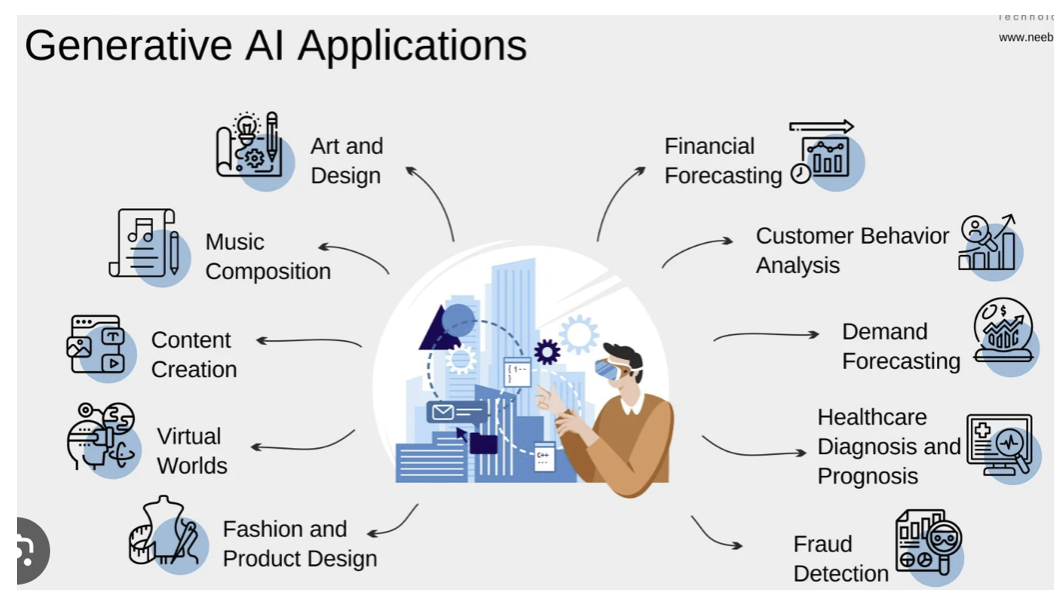
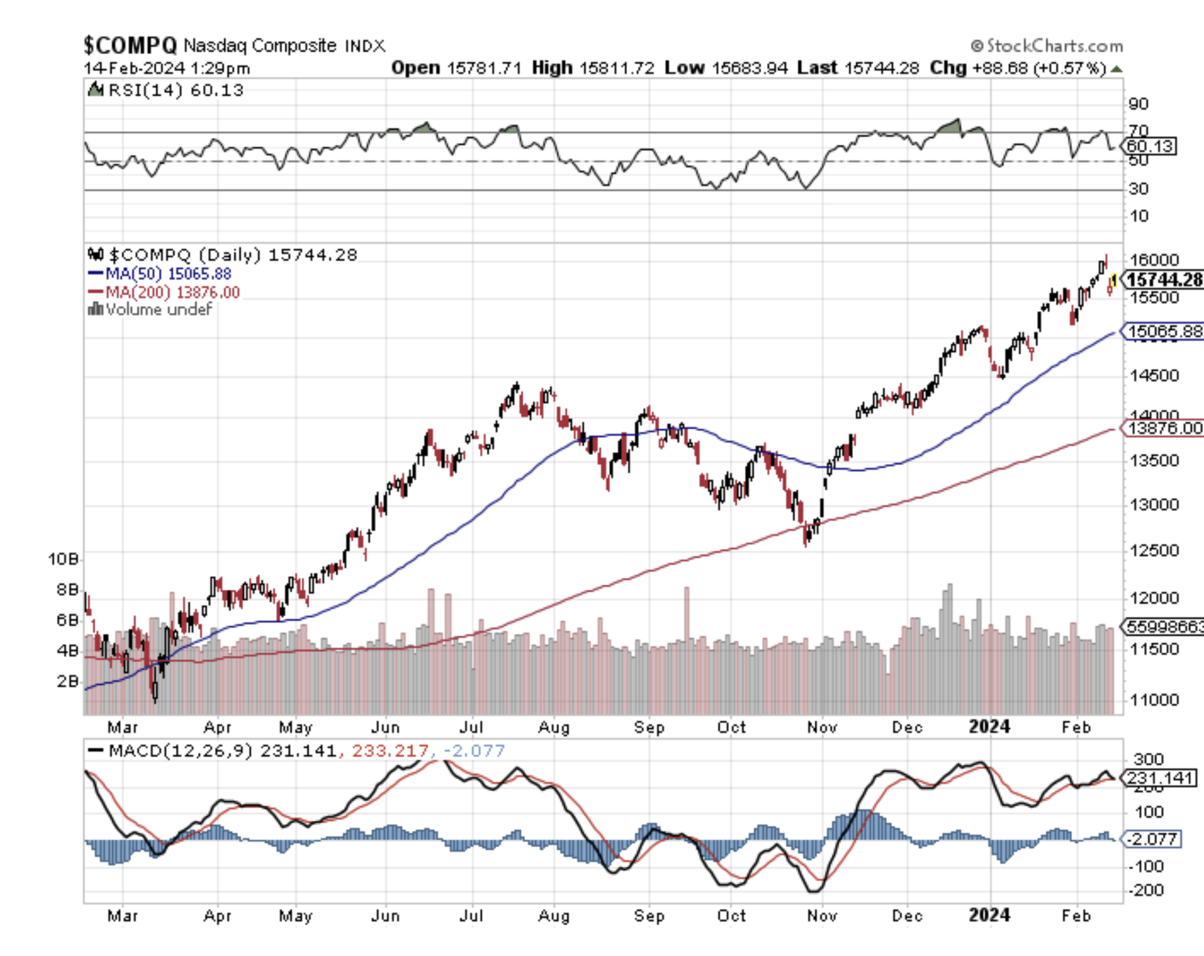
Mad Hedge Technology Letter
January 8, 2024
Fiat Lux
Featured Trade:
(S174)
($COMPQ)

One of the least talked about tax code blunders S174 could derail Silicon Valley ($COMPQ).
What happened?
Basically, all costs related to R&D cannot be expensed, including labor for software development.
These costs have to be capitalized and amortized over 5 years – or 15 if labor is done outside of the US.
This is a massive game changer that makes IT salaries substantially more expensive on paper.
This topic has come up a few times in private conversations that I have had, even though startups are arguably the hardest-hit companies of all.
What’s the fallout?
An unexpectedly high tax bill out of nowhere.
Many US software businesses amassed surprisingly high tax bills in 2023, seemingly out of nowhere, due to a tax change that took effect in July of the previous year, which many small companies knew nothing about until finalizing their 2022 returns.
The change was expected to be repealed (reversed) in December 2022, so many accountants didn’t inform customers for that reason. So, businesses got a surprise when the first tax payments fell due last April.
The amendment to S174 means employing software engineers can no longer be accounted as a direct cost in the year they are paid – unlike the norm, globally. Here’s a simplified example of the change from the final tax year before the change.
Here is how amortization works:
Less hiring of software engineers and more software engineering layoffs are already happening at smaller US tech companies.
This could slash around 100,000 software developers at small companies.
One of these changes was Section 174, set to come into effect 5 years later, in 2022. These parts deliver the blow by making it clear that software development costs need to be amortized over 5-15 years.
What’s the damage?
Microsoft: $4.8B additional tax paid in 2023. The company generated a $72B profit that year, so this tax increase was manageable. It’s still a very large amount!
Netflix: around $368M in additional tax paid – also manageable with $4.4B annual profit.
What’s the key takeaway?
Innovation across all US software companies will take a hit if Section 174 isn’t repealed.
The tax change incentivizes software companies without large cash reserves to invest less in research and development. Or they can just move abroad.
But the change isn’t just bad for small software companies; it hurts even the largest ones – it is why Microsoft and Amazon are also advocating for its reversal.
I won’t pretend that Silicon Valley is full of little companies because it’s not.
I can easily see many firms like Google and Apple offshoring more jobs abroad for lower wages if they cannot amortize the full amount of wages in one year.
It puts American tech at an acute disadvantage, but I do believe US tech is so far ahead of its peers than in the long term, it won’t matter too much.
Just take Europe, many of the backwater countries are just a fraction of the size of Apple or Microsoft.
US tech is gargantuan and we forget that sometimes.
In the short term, the pressure is squarely asserted on the balance sheet. How will Silicon Valley nudge up the EPS with even more expenses coming down the pipeline?
The solution is clearly firing more American developers and reallocating the workload to other colleagues and a partial workload will go to AI.
US tech is famous for working smarter and this is just another hurdle to jump over.
In the first part of the year, this puts a lot of pressure on external tailwinds mainly the Fed pivot to power us through to new highs.
Buy the dip in tech.
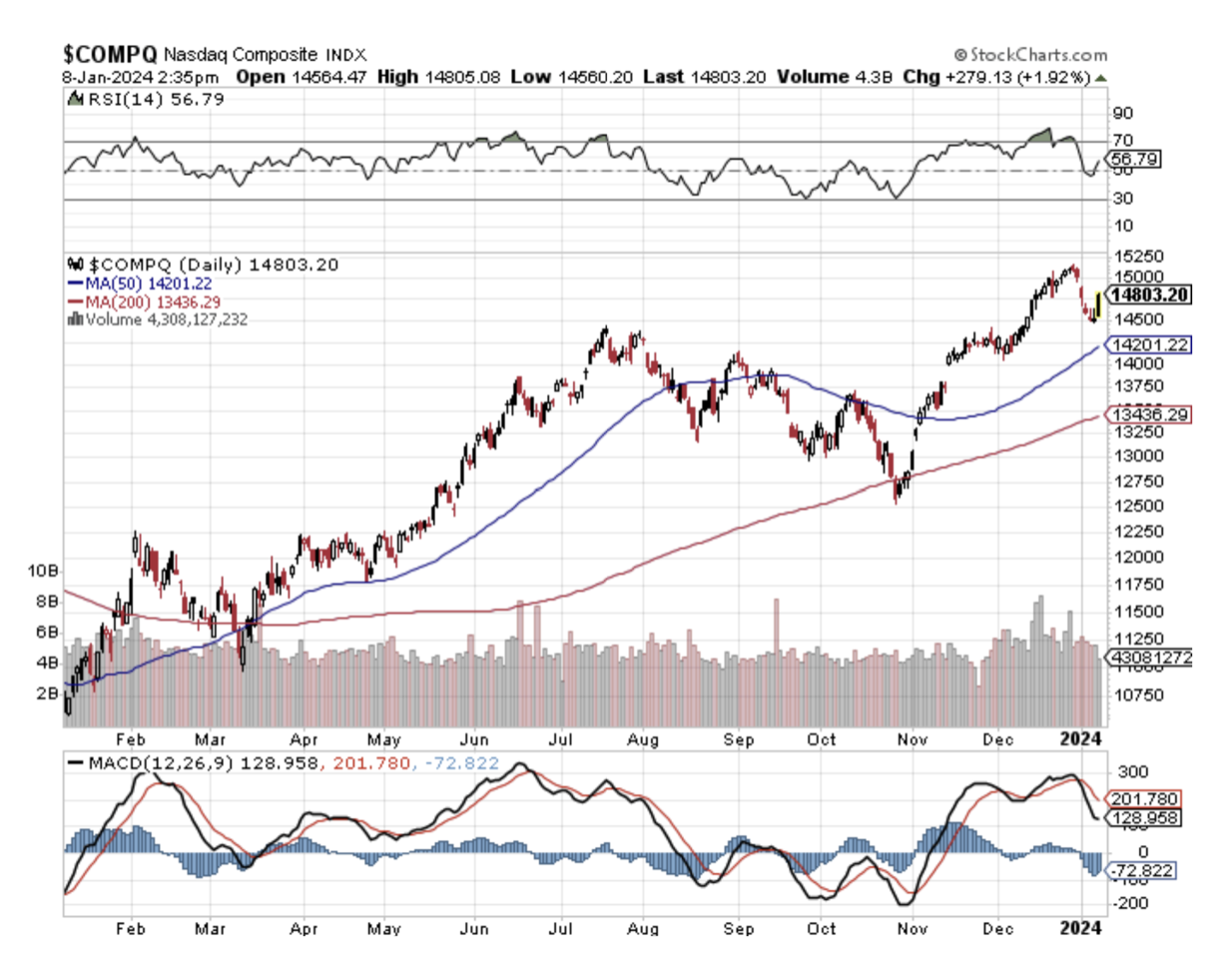
Mad Hedge Technology Letter
January 5, 2024
Fiat Lux
Featured Trade:
(SILICON VALLEY AND THE US ECONOMY HEATS UP)
($COMPQ)

In December, the US economy and the American tech sector ($COMPQ) showed who is boss in the world economy by blasting past employment expectations.
This comes at a time when every professional economist is calling for a gloomy outcome in the short term.
From the tech side of the equation, remote jobs are rebounding at a blistering pace.
Full-time workers plunged by 1.5 million in just one month to the lowest since February 2023.
Part-time workers made gains of 762,000 the highest on record.
Multiple jobholders hit a time-high 8.56 million.
What does this tell us?
Work from home can do more than one job and those are mainly tech jobs. A lot of the time they are IT and software engineering jobs as well.
The other group this could have affected is the group affected by Bidenflation which has crippled the budget of many low-income workers living in the US and this cohort needs two low-paid jobs.
The reality is that these multiple job holders are a mix of each group.
It’s now highly common for remote workers to work 3 or 4 jobs at once because these workers don’t need to be physically present in any office.
They can simply clock in and clock out when they choose to and this has been a boon for tech companies who have taken advantage of this trend and fired many full-time workers who became too pricey.
For the past year, Silicon Valley has taken a machete and chopped off the fat from its business model.
Their leanness was a massive reason for the overperformance of tech stocks last year and even though that same boost won’t happen to the same extent in 2024, it has given the blueprint to management on how to run a tech company.
The largest economy in the world saw the addition of 216,000 new jobs in December 2023, surpassing projections of a decline from the previous month, as per data from the Labour Department.
The joblessness rate remained steady at 3.7 percent, a figure that is notably low historically and counters predictions of a slight increase.
These impressive job market statistics arise amidst the context of rising interest rates. The Federal Reserve has aggressively raised and maintained high rates for the benchmark lending rate to moderate demand and control inflation.
In terms of wages, December witnessed a consistent rise, with a 0.4 percent increase from November 2023, according to the Labor Department. Year-over-year, average hourly earnings went up by 4.1 percent.
Tech jobs are evolving into a different type of existence with agility becoming more important and that is highly positive for tech companies.
Silicon Valley was at the forefront of the firing spree last year, but job numbers were more than compensated by the additions in government, health care, and services.
The strength of the US economy means that it’s painfully obvious that traders are still too early betting that the Fed will drop rates by 1.5% by the end of 2024.
My belief is that we will end up with a drop of .5%-.75% of Fed Funds rate cuts which means we have a little ways to go to reverse from this overshoot.
This idea that the economy is stronger than people think is verified by rising wages and lower unemployment.
I do believe that high inflation and high rates are here to stay and the 0% rate of yore was just a weird anomaly that defied historic data.
Delaying the “recession” yet another year means once we absorb this pullback, tech stocks will be off to the races again.

Mad Hedge Technology Letter
November 22, 2023
Fiat Lux
Featured Trade:
(YEN COULD DRAG DOWN TECH STOCKS)
(FXY), ($COMPQ), (WEWKQ), (SOFTBANK)

The Japanese yen has helped boost tech stocks ($COMPQ).
Institutional money is borrowing Japanese yen (FXY) by the bucketful because Japanese interest rates have been anchored at 0% and betting big on tech stocks.
The strategy has worked like clockwork and Japanese stocks have also felt the wind at its sails.
What now?
Lurking in the shadows is a potentially catastrophic problem called Japanese tech company Softbank.
Softbank reported a "shocking" Q2-2 loss, revealing, in particular, how dangerously exposed they are to a Japanese yen devaluation.
Selling in Softbank stock would trigger panic selling in Japanese Banks. The contagion risk here is crystal clear.
JGB yields will spike following the US Treasury yields overnight trend. This will put even further pressure on banks' liquidity with a risk of exacerbating the sell-off.
What's important to understand here is the risk of Softbank triggering a $226 billion (the total amount of Softbank balance sheet liabilities) credit event right now.
To begin with, with a BB rating from S&P, Softbank has a pitiful credit rating tying its hands.
Now Softbank has liabilities mostly in US dollars while on the hook to repay $48 billion in the next 12 months.
Days before WeWork (WEWKQ) filed for bankruptcy, Softbank paid $1.5 billion to WeWork bank lenders.
In total, Softbank had to write off more than $14 billion in US dollars on that terrible WeWork investment while the Japanese yen crashed.
Now here the big problem is that Softbank doesn't disclose the amount of "off-balance-sheet" guarantees they issued either directly or through the Vision Fund.
Lastly, things might turn quite bad for Masayoshi Son personally, because 35% of his personal shares in Softbank are already pledged to financial institutions.
It doesn't take much to figure out what financial institutions will do if Softbank stock starts crashing, right?
The Japanese government will need to bail out not only Softbank but also the Japanese banks.
This tinderbox could explode anytime and the Yen would then become the focus.
If the Japanese government finally does embark on an interest hiking cycle then under this scenario, the Bank of Japan would be forced to raise the cost of capital on investors and households.
The global and Japanese financial system isn’t ready to take away the low-interest carry trade and it’s hard to quantify the unintended consequences.
Large parts of the Japanese system could go under water and the Japanese yen would greatly strengthen.
I specifically am worried about all the adjustable loans taken out by the Japanese consumer.
Loan defaults would surge.
If the Japanese government is forced to save Softbank and the Japanese financial system then expect another tidal wave of inflation as the purchasing power of the Japanese yen is even more devalued.
The string of abysmal tech investments by Softbank is threatening to accelerate the financial death spiral in Japan.
In my view, this would ice the tech rally momentarily, but not derail it long-term.
In all honesty, Softbank did deliver ample liquidity to many poorly run Silicon Valley tech companies and this fortified tech stocks during the bull run.
Now Softbank cannot throw around the cash they used to and tech stocks have concentrated into a group of 7 outperformers.
In the short term, the tech bull run continues in just a few narrow names but 2024 could trigger a broader run in secondary tech names as well.
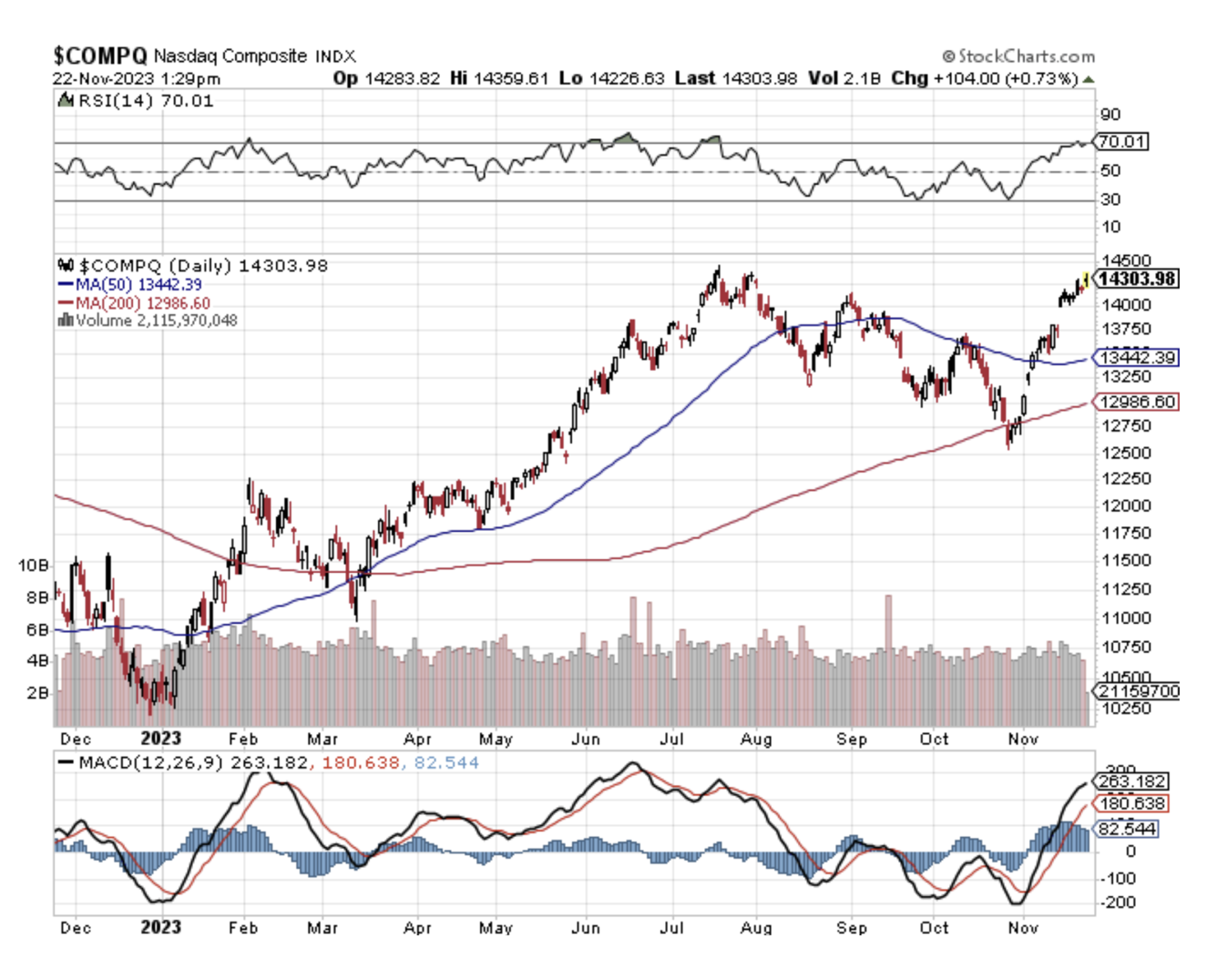
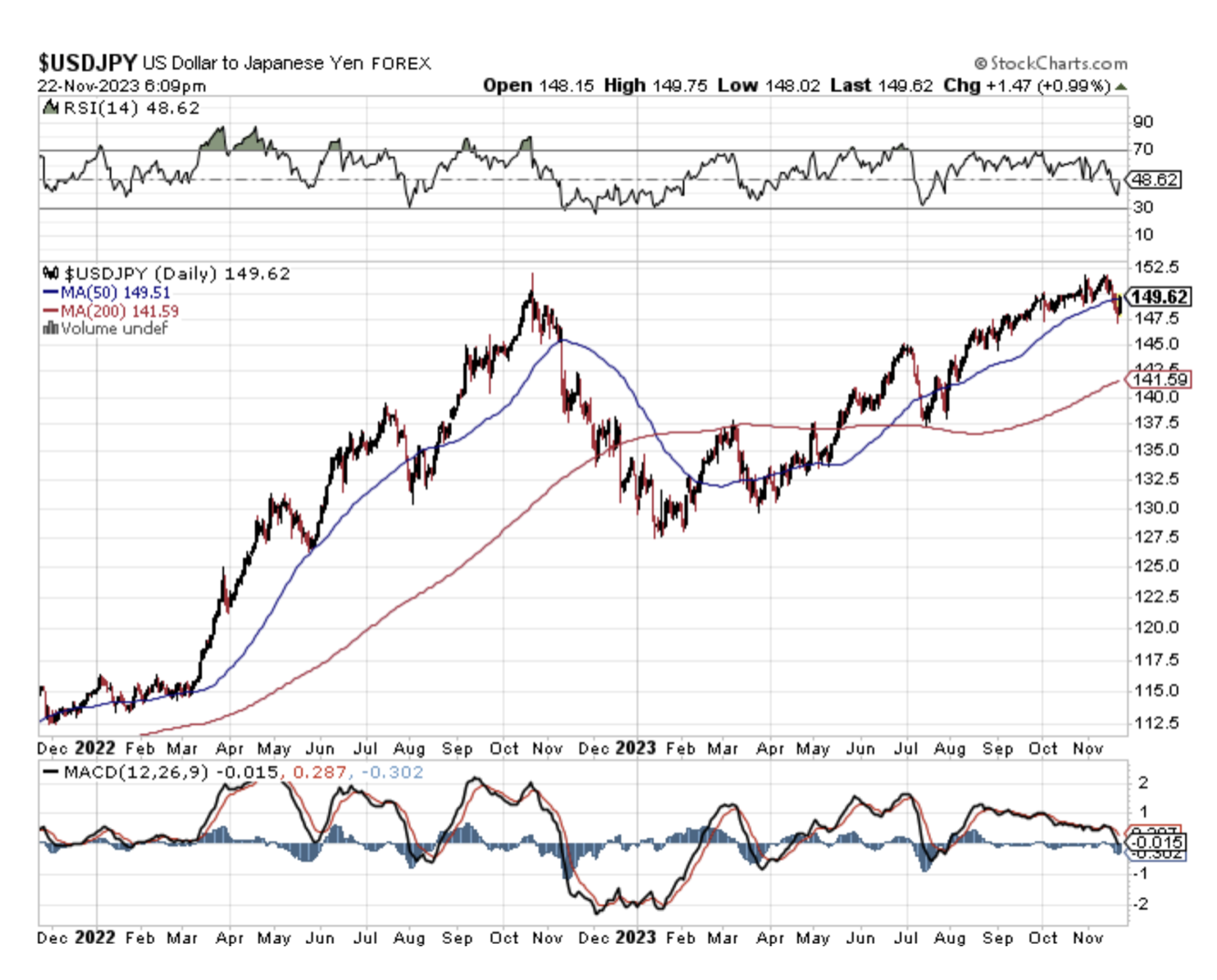
Mad Hedge Technology Letter
October 30, 2023
Fiat Lux
Featured Trade:
(WHY MEGACAP TECH IS THE ONLY SHOW IN TOWN)
(BIG TECH), (ETF), (COMPQ)

Megacap stocks continue to make hay when the sun shines in 2023.
The question is, why?
After all, many other great companies have arguably much better valuations, fundamentals, and affordable PE ratios.
Big tech stocks are expensive, yet buyers keep maneuvering to bid up the stock.
What gives?
The surge in the most hated sectors last year has been the main driver of this year’s stellar equity performance.
If we strip out tech, performance is actually negative if you can believe it.
The question is, why are professional managers seemingly chasing big tech like no other stocks exist?
The answer is more simplistic than you may think.
For investment managers, generating “alpha” is necessary to limit “career risk.”
If a manager underperforms their relative benchmark index for a time that is noticeable, they start to get in the firing line.
Currently, there are two drivers for the mega-capitalization stock chase. First, these stocks are highly liquid, and managers can quickly move money into and out without significant price movements.
The second is the passive indexing effect.
As investors change their investing habits from buying individual stocks to the ease of buying a broad index, the inflows of capital unequally shift into the largest capitalization stocks in the index.
Over the last decade, the inflows into exchange-traded funds (ETFs) have exploded.
That ETF issuance surge and the assets’ growth under management fuel the performance of the top 10 stocks. As we discussed previously:
Therefore, as investors buy shares of a passive ETF, the shares of all the underlying companies must be purchased.
Given the massive inflows into ETFs over the last year and subsequent inflows into the top-10 stocks, the mirage of market stability is not surprising.
Given stick high interest rates, inflation, and reversal of monetary liquidity post-pandemic, the risk of recession is higher than normal.
Higher interest rates, in particular, currently pose the largest threat to small and medium-sized companies.
The largest 10% of companies represent 62% of the overall non-financial market cap of the S&P 1500.
Smaller firms do not have the massive cash balances the megacap companies hold which puts them at a disadvantage.
As that debt wall of term loans hits over the next few years, higher borrowing costs are going to raise the risk of defaults and bankruptcies.
Tightening financial conditions have seen corporate bankruptcies rise by 71% since last year. If financial conditions are still elevated over the next few years, that bankruptcy risk increases markedly.
They weren’t able to lock into long-term loans at almost zero interest rates and pile it high in the money markets at variable rates.
Ultimately the pain for US small- and mid-cap companies will trigger the recession.
Portfolio managers must chase the market higher or potentially suffer career risk. Therefore, the easiest place to allocate cash is the mega-capitalization companies with low risk of bankruptcy or default and extremely high liquidity.
With the concentration of risk in a handful of stocks, the markets are set for a rather vicious cycle.
The concentration at the top keeps getting worse and I do believe we are one cycle away from the top 7 tech stocks comprising 35% of the total equity market.
It’s quite bizarre that something even remote could materialize, but that is where we stand where investors are looking for safety.
Throw in that most investors with a high net worth aren’t young, the tendency to go with a more conservative approach will shine through.
Funnily enough, tech investments in the big 7 constitute as conservative and it’s really true when I say that big tech has aged with its investor base.

Legal Disclaimer
There is a very high degree of risk involved in trading. Past results are not indicative of future returns. MadHedgeFundTrader.com and all individuals affiliated with this site assume no responsibilities for your trading and investment results. The indicators, strategies, columns, articles and all other features are for educational purposes only and should not be construed as investment advice. Information for futures trading observations are obtained from sources believed to be reliable, but we do not warrant its completeness or accuracy, or warrant any results from the use of the information. Your use of the trading observations is entirely at your own risk and it is your sole responsibility to evaluate the accuracy, completeness and usefulness of the information. You must assess the risk of any trade with your broker and make your own independent decisions regarding any securities mentioned herein. Affiliates of MadHedgeFundTrader.com may have a position or effect transactions in the securities described herein (or options thereon) and/or otherwise employ trading strategies that may be consistent or inconsistent with the provided strategies.
This site uses cookies. By continuing to browse the site, you are agreeing to our use of cookies.
OKLearn moreWe may request cookies to be set on your device. We use cookies to let us know when you visit our websites, how you interact with us, to enrich your user experience, and to customize your relationship with our website.
Click on the different category headings to find out more. You can also change some of your preferences. Note that blocking some types of cookies may impact your experience on our websites and the services we are able to offer.
These cookies are strictly necessary to provide you with services available through our website and to use some of its features.
Because these cookies are strictly necessary to deliver the website, refuseing them will have impact how our site functions. You always can block or delete cookies by changing your browser settings and force blocking all cookies on this website. But this will always prompt you to accept/refuse cookies when revisiting our site.
We fully respect if you want to refuse cookies but to avoid asking you again and again kindly allow us to store a cookie for that. You are free to opt out any time or opt in for other cookies to get a better experience. If you refuse cookies we will remove all set cookies in our domain.
We provide you with a list of stored cookies on your computer in our domain so you can check what we stored. Due to security reasons we are not able to show or modify cookies from other domains. You can check these in your browser security settings.
These cookies collect information that is used either in aggregate form to help us understand how our website is being used or how effective our marketing campaigns are, or to help us customize our website and application for you in order to enhance your experience.
If you do not want that we track your visist to our site you can disable tracking in your browser here:
We also use different external services like Google Webfonts, Google Maps, and external Video providers. Since these providers may collect personal data like your IP address we allow you to block them here. Please be aware that this might heavily reduce the functionality and appearance of our site. Changes will take effect once you reload the page.
Google Webfont Settings:
Google Map Settings:
Vimeo and Youtube video embeds:
